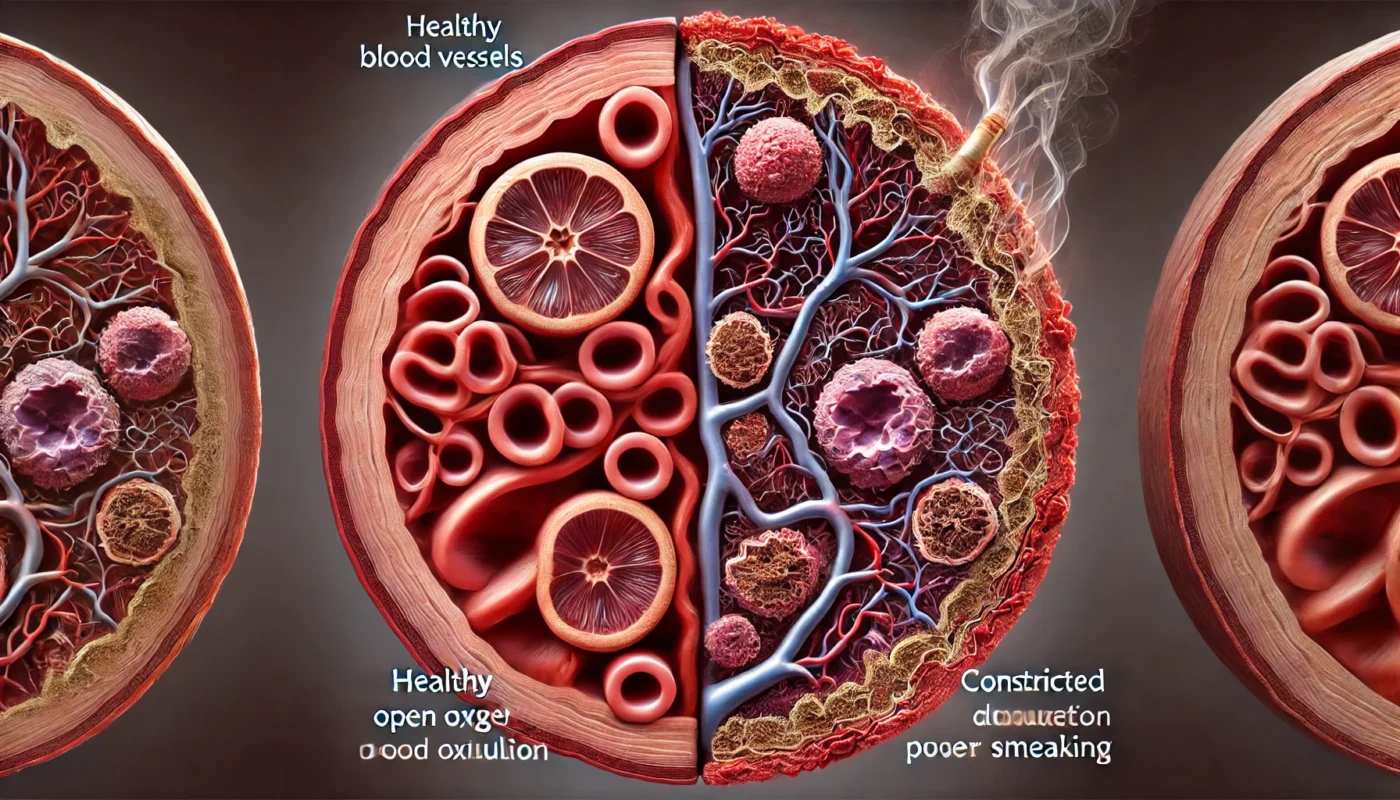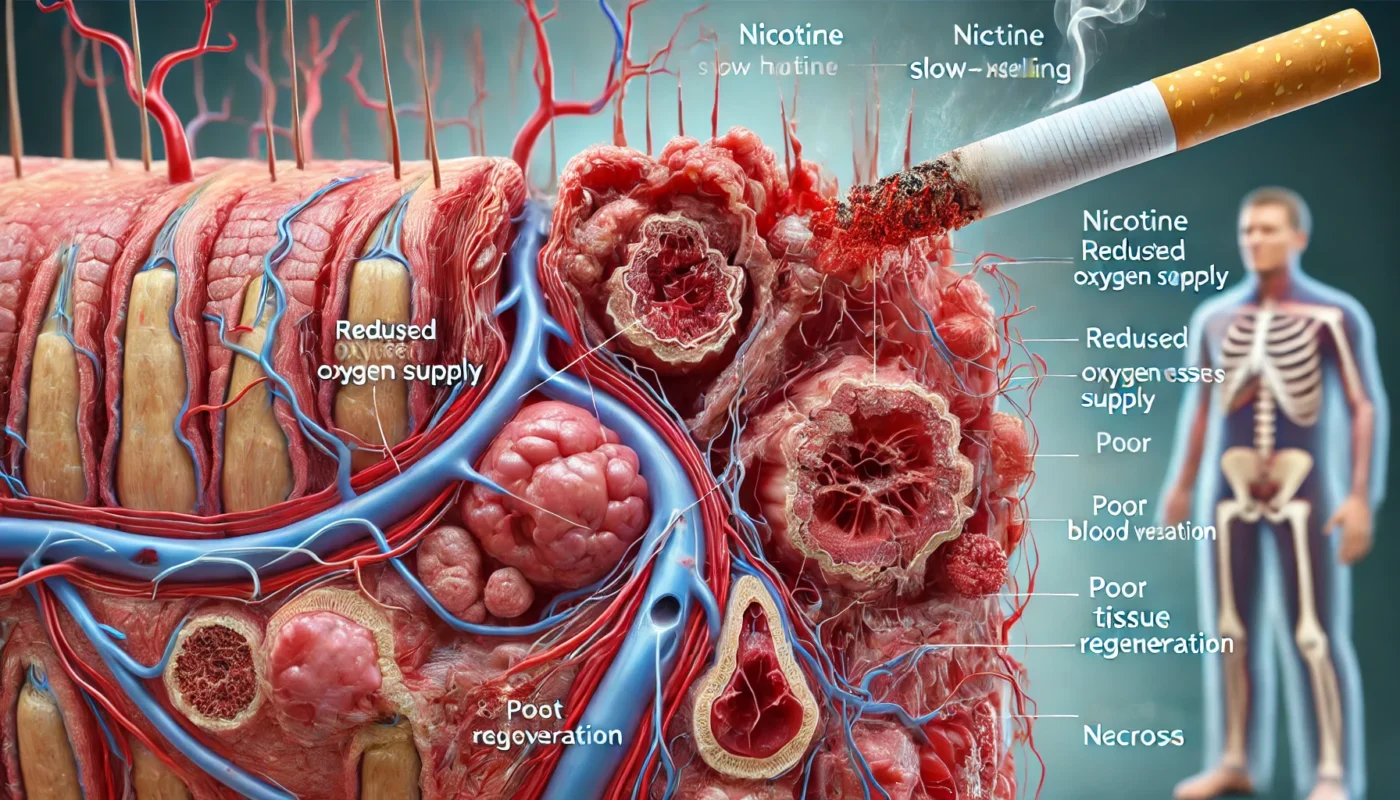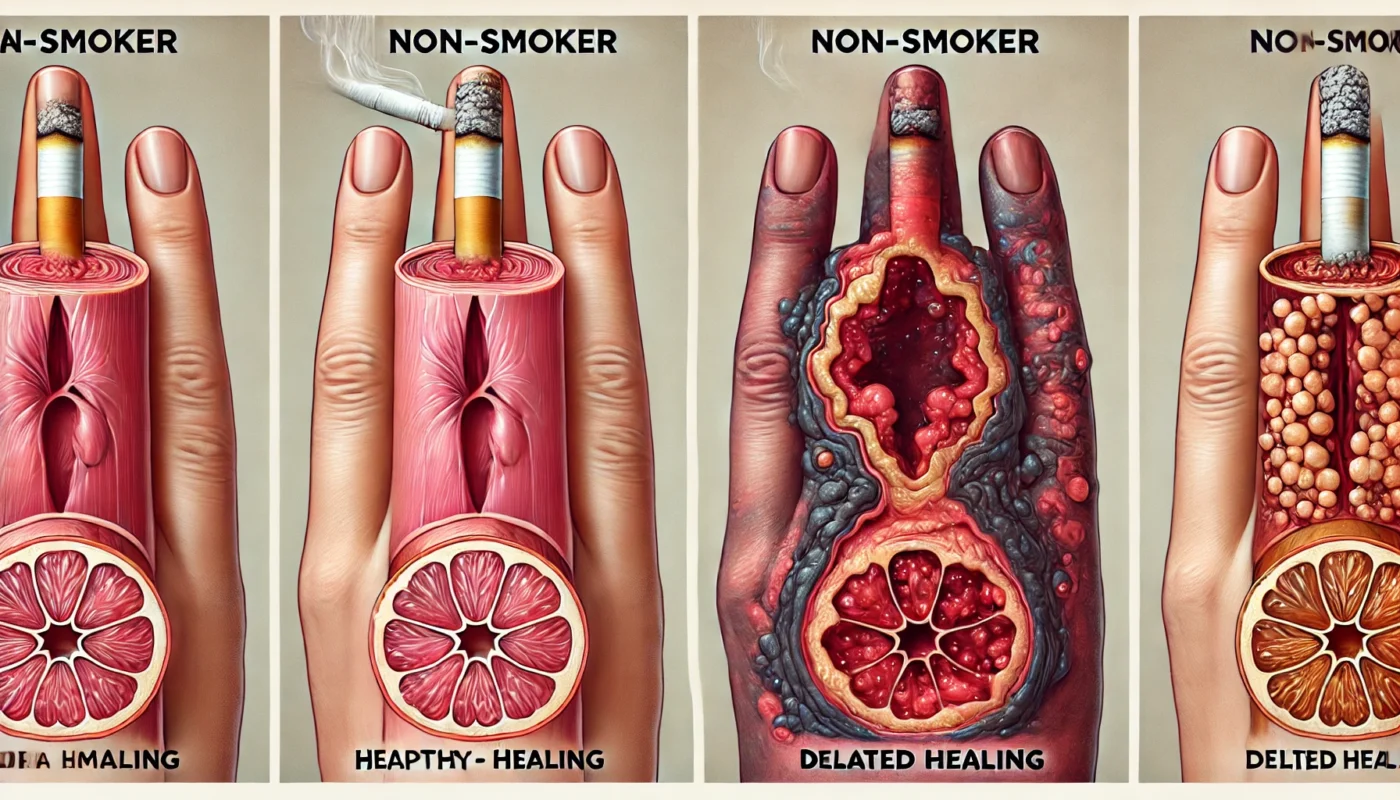When it comes to healing wounds, the body’s ability to repair itself is nothing short of miraculous. However, several factors can impede this natural process, and smoking is a significant one. In this article, we delve into how smoking affects wound healing, how much it slows down the process, and whether nicotine plays a role in this detrimental effect.
You may also like: Common Causes of Delayed Wound Healing
Understanding Smoking and Skin Healing
The relationship between smoking and wound healing is well-documented, yet often underestimated. Smoking introduces a host of chemicals into the body, many of which have adverse effects on the skin’s ability to heal. But how exactly does smoking slow down the healing process?
The Chemistry of Smoking
Cigarettes contain thousands of chemicals, many of which are harmful to human health. Among these, nicotine, carbon monoxide, and tar are particularly detrimental to wound healing. Nicotine causes vasoconstriction, limiting blood flow, while carbon monoxide reduces oxygen delivery to tissues. Tar, a sticky substance, clogs the lungs, affecting the respiratory system and overall oxygenation levels.
How Chemicals Affect Skin Cells
The harmful chemicals in cigarettes directly impact skin cells by altering their normal function. These substances lead to cellular damage and inflammation, disrupting the skin’s natural repair mechanisms. The presence of these chemicals can also trigger oxidative stress, which damages cell structures and DNA, further hindering healing.
The Systemic Impact of Smoking
Beyond localized effects on the skin, smoking has systemic impacts that affect wound healing. It weakens the immune system, making the body more susceptible to infections. The reduced efficiency of the immune system means wounds take longer to heal, as the body struggles to fight off bacteria and other pathogens.
How Much Does Smoking Slow Down the Healing Process?
Smoking can significantly delay wound healing times. Research indicates that smokers may experience double the recovery time compared to non-smokers. This delay is due to several factors, including reduced blood flow, oxygen deprivation, and the presence of harmful chemicals that interfere with the body’s natural healing mechanisms.
The Role of Blood Flow in Healing
Blood flow is crucial for delivering oxygen and nutrients to the wound site, both of which are essential for healing. Smoking constricts blood vessels, significantly reducing circulation. This limited blood flow means that vital components for tissue repair are not adequately delivered, slowing down the healing process.
Oxygen Deprivation and Its Consequences
Oxygen is vital for the cellular processes that underpin wound healing. It aids in energy production, collagen synthesis, and the formation of new blood vessels. Smoking reduces the amount of oxygen available to tissues, which can cause hypoxia. This oxygen deprivation slows down the production of collagen, a protein crucial for skin integrity and repair.
Increased Risk of Infection and Complications
The delay in healing due to smoking increases the risk of wound infections and other complications. An extended healing period allows more time for bacteria to colonize the wound, potentially leading to infections. Complications such as necrosis and wound dehiscence are also more common among smokers due to impaired immune response and tissue regeneration.

Does Nicotine Inhibit Healing?
Nicotine, a primary component of tobacco, is notorious for its addictive properties, but its impact on wound healing is equally concerning. Nicotine contributes to vasoconstriction, which is the narrowing of blood vessels. This action limits blood supply to the tissues, exacerbating the healing challenges caused by smoking.
The Effects of Vasoconstriction
Vasoconstriction caused by nicotine leads to reduced blood supply, impacting tissue perfusion. This restriction not only slows healing but also increases the likelihood of wound breakdown. The lack of adequate blood supply means that healing tissues are deprived of oxygen and nutrients, leading to delays in the repair process.
Impact on Inflammatory Response
The inflammatory response is a critical phase in wound healing, involving the recruitment of white blood cells to the wound site. Nicotine impairs this response, affecting the body’s ability to fight infection. As white blood cells are less effective, the risk of infection increases, and the healing process is further delayed.
Long-term Effects on Tissue Regeneration
Chronic exposure to nicotine can have long-term effects on tissue regeneration. Over time, nicotine disrupts the normal cycle of cell growth and repair, leading to weaker tissue formation. This compromised tissue integrity can result in scars that are more prone to breakdown and slower to heal in the future.
Smoking and Wound Healing: The Science Behind It
The scientific community has extensively studied the effects of smoking on wound healing. Numerous studies reveal that smokers are at a higher risk of wound complications, such as infections, necrosis, and dehiscence, compared to non-smokers. This evidence underscores the importance of smoking cessation, particularly before and after surgical procedures or injury.
Scientific Studies and Findings
Several studies have demonstrated the negative impact of smoking on wound healing. Research consistently shows that smokers face longer healing times and higher rates of complications. These studies highlight the biological mechanisms disrupted by smoking, providing a clearer understanding of its detrimental effects.
The Importance of Smoking Cessation in Clinical Settings
In clinical settings, smoking cessation is a critical component of pre- and post-operative care. Surgeons often recommend quitting smoking before surgery to enhance healing outcomes. Smoking cessation leads to improved circulation and oxygenation, reducing the risk of post-surgical infections and complications.
Public Health Implications
The impact of smoking on wound healing has significant public health implications. Increased healing times and complications lead to longer hospital stays and higher healthcare costs. Public health campaigns aimed at reducing smoking can improve health outcomes and reduce the burden on healthcare systems.

The Role of Carbon Monoxide and Cyanide
In addition to nicotine, other harmful substances in cigarettes, such as carbon monoxide and hydrogen cyanide, play a detrimental role in wound healing. Carbon monoxide binds to hemoglobin more effectively than oxygen, reducing the amount of oxygen available to tissues. Oxygen is vital for cellular metabolism and repair; thus, its deficiency can stall the healing process.
Carbon Monoxide’s Effect on Oxygenation
Carbon monoxide’s strong affinity for hemoglobin reduces the oxygen-carrying capacity of blood. This reduction leads to tissue hypoxia, impairing cellular functions necessary for healing. Without sufficient oxygen, cells cannot produce the energy needed for repair, leading to delays and complications.
Hydrogen Cyanide and Cellular Metabolism
Hydrogen cyanide affects cellular metabolism by inhibiting enzymes necessary for energy production. This interference disrupts cellular respiration, decreasing the energy available for healing. The lack of energy stalls the repair processes, resulting in prolonged healing times.
Combined Effects of Multiple Toxins
The combined effects of carbon monoxide, hydrogen cyanide, and other cigarette toxins create a hostile environment for wound healing. These substances work synergistically to impair various aspects of the healing process. Understanding these combined effects highlights the importance of smoking cessation for optimal healing.
Practical Strategies for Optimizing Healing
While the negative impact of smoking on wound healing is significant, there are practical strategies that can help mitigate these effects and promote recovery.
Smoking Cessation
Quitting smoking is, undoubtedly, the most effective way to enhance wound healing. The benefits of smoking cessation are profound and include improved circulation, increased oxygen levels, and enhanced immune function. These changes collectively accelerate the healing process and reduce the risk of complications.
The Benefits of Quitting
The benefits of quitting smoking extend beyond improved wound healing. Smokers who quit experience better overall health, reduced risk of chronic diseases, and improved quality of life. The body’s natural healing processes are restored, leading to faster recovery times and reduced risk of complications.
Support Systems and Resources
For those who find quitting challenging, consider seeking support from healthcare professionals, counseling services, or smoking cessation programs. Support systems provide guidance and encouragement, making the quitting process more manageable. Many programs offer resources such as hotlines, support groups, and online communities.
Nicotine Replacement Therapies
Nicotine replacement therapies, such as patches or gums, can also aid in managing withdrawal symptoms while reducing the harmful effects of smoking. These therapies provide controlled doses of nicotine, helping to ease cravings and withdrawal symptoms. When used in conjunction with behavioral support, they increase the chances of successful cessation.
Nutritional Support
Nutrition plays a pivotal role in wound healing. A diet rich in vitamins and minerals, particularly Vitamin C, Zinc, and Protein, can bolster the body’s repair mechanisms. Vitamin C is essential for collagen synthesis, a critical component of skin and tissue repair. Zinc supports immune function and cell proliferation, while protein provides the building blocks for new tissue formation.
Key Nutrients for Healing
Certain nutrients are particularly important for wound healing. Vitamin C, found in citrus fruits and vegetables, is vital for collagen production. Zinc, present in meat, seafood, and legumes, supports immune health. Protein, essential for new tissue growth, can be found in lean meats, eggs, and dairy products.
Hydration and Its Importance
Adequate hydration is essential for optimal wound healing. Water supports cellular functions and helps maintain skin elasticity. Staying hydrated ensures that nutrients are efficiently transported to the wound site, facilitating the healing process.
The Role of Supplements
Supplements can also play a role in enhancing wound healing. Multivitamins and mineral supplements can help fill nutritional gaps, particularly for individuals with dietary restrictions. However, it’s important to consult with a healthcare professional before starting any supplement regimen.
Holistic and Alternative Approaches
Holistic and alternative approaches can complement traditional methods in promoting wound healing. Practices such as meditation and yoga can reduce stress, which is known to impede healing. Additionally, herbal supplements like turmeric and aloe vera have anti-inflammatory properties that may support recovery.
Stress Reduction Techniques
Stress can negatively impact the body’s ability to heal. Techniques such as meditation, deep breathing, and yoga promote relaxation and reduce stress levels. By managing stress, individuals can create a more favorable environment for wound healing.
Herbal Remedies and Their Benefits
Herbal remedies have been used for centuries to promote healing. Turmeric, known for its anti-inflammatory properties, can be taken as a supplement or added to food. Aloe vera, applied topically, soothes and promotes skin regeneration, aiding in the healing process.
Integrating Alternative Therapies
Integrating alternative therapies with conventional treatments can enhance healing outcomes. Acupuncture, massage, and aromatherapy are additional options that may support recovery. It’s important to discuss these therapies with a healthcare provider to ensure they complement traditional treatments safely.

Conclusion
The impact of smoking on wound healing is profound, with nicotine and other harmful substances in cigarettes significantly slowing down the recovery process. However, by understanding these effects and implementing practical strategies, individuals can enhance their healing outcomes.
Quitting smoking, adopting a nutrient-rich diet, and exploring holistic approaches can all contribute to faster, more effective wound healing. While the journey to quitting smoking may be challenging, the benefits for wound healing and overall health are well worth the effort.
In summary, the road to recovery is smoother and shorter for those who choose to put out the cigarette for good. If you’re facing a wound or preparing for surgery, consider these insights as a roadmap to optimal healing and well-being. By taking proactive steps, individuals can significantly improve their chances of a swift and complication-free recovery.
Further Reading:
Vaping Slows Wound Healing Just as Much as Smoking
How Does Smoking Affect Wound Healing?
quitting smoking, wound healing, smoking cessation, nutrition, hydration, supplements, stress reduction, herbal remedies, alternative therapies, nicotine replacement, immune function, recovery, health benefits, holistic approaches, healing nutrients
Important Note: The information contained in this article is for general informational purposes only, and should not be construed as health or medical advice, nor is it intended to diagnose, prevent, treat, or cure any disease or health condition. Before embarking on any diet, fitness regimen, or program of nutritional supplementation, it is advisable to consult your healthcare professional in order to determine its safety and probable efficacy in terms of your individual state of health.
Regarding Nutritional Supplements Or Other Non-Prescription Health Products: If any nutritional supplements or other non-prescription health products are mentioned in the foregoing article, any claims or statements made about them have not been evaluated by the U.S. Food and Drug Administration, and such nutritional supplements or other health products are not intended to diagnose, treat, cure, or prevent any disease.

